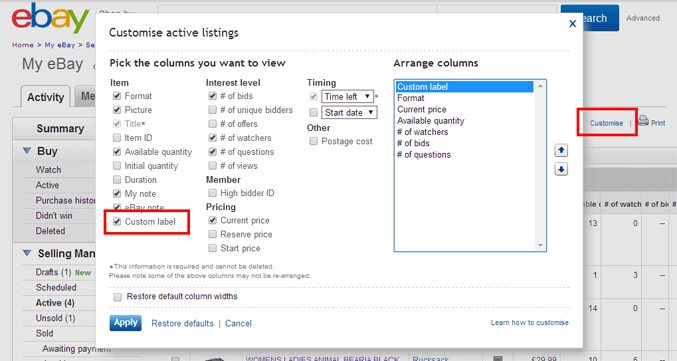 This week Matthew Ogborne, co-Founder of UnderstandingE.com is authoring a five part series on Tamebay – “The Ultimate Guide to Multi-Channel Software”. Yesterday we published Part 1 “What is Multi-Channel Software?” and today in “The Key aka the Stock Number” Matt starts to look at how you can manage your stock when selling across multiple channels.
This week Matthew Ogborne, co-Founder of UnderstandingE.com is authoring a five part series on Tamebay – “The Ultimate Guide to Multi-Channel Software”. Yesterday we published Part 1 “What is Multi-Channel Software?” and today in “The Key aka the Stock Number” Matt starts to look at how you can manage your stock when selling across multiple channels.
The Key aka the Stock Number
Following on from part 1 of this series where we had a high level overview to what multichannel software is, in this part we’ll be focusing upon the one key part of any Multi Channel software, stock control.
The moment you add in one more sales channel to your business, another eBay site, another eBay account, expand onto Amazon or add in an additional website, the primary concern will be around keeping your stock levels true.
And this is exactly the kind of challenge that software can step-up-to and aid your business with.
Starting Small
Let’s say that you currently just sell on eBay.
Up until now stock control hasn’t really been a challenge for you, however the game changes the second that you add in an additional sales channel. So lets now say you expand your business by adding in an Amazon account.
If you have the same product for sale on eBay and on Amazon at the same time, let’s say a sun umbrella, the moment you receive an order on eBay, your stock level on Amazon is incorrect and needs to be reduced by the number of sun umbrellas you’ve sold.
Then when you have new stock arrive and you have 10 more umbrellas available you need to update both eBay and Amazon.
Add in another eBay account, Rakuten and/or a website and as you can imagine, things could get wild rather quickly.
This is where software can step up and help you automate the updating of stock levels automatically.
Pro Tip:
As a general rule, if you’re not selling on Amazon yet, expect to do the same sales volume as you are doing on eBay now and of course vice-versa too. Websites take longer and require a different approach as they generally don’t have an active pool of waiting customers like eBay or Amazon, however they can be profitable long term.
The Key
We’ll be looking at the topic of inventory management in the next part of this series ( tomorrow ), however for now being able to update stock levels across one or more sales channels falls down to one thing, a key.
And the key is… A stock number.
A “Stock Number” or Stock Keeping Unit, aka a “SKU” is simply an identifier to help you and software identify one product in your inventory. Just like a door key, your front door key should only fit your front door.
This could be as simple as the number “1” or as complex as you need it such as “UMB001-BLUE”, the thing is that one stock number equals one product.
Note:
This also applies to products that come in variations, so for example if you’re selling footwear in sizes, 6, 7, 8, 9 & 10, each of these are separate products and will require their own stock number. eg SHOE-6, SHOE-7, SHOE-8 etc…
On eBay this is called a “Custom Label”, on Amazon “Merchant SKU” and in Magento a “SKU”. They all mean the same thing and this is the key to you being able to use multi channel software to keep the stock levels up to date.
Pro Tip:
By default eBay hides the “Custom Label” column on many of the “My eBay” pages. You can make this column show by pressing the “Customise” button on the top right and in the pop-up window, select “Custom Label” and rearrange it’s position on the page. Personally I prefer this as the first column.
Naming Stock Numbers
There is no right or wrong way of creating stock numbers, however the KISS principle works best ( Keep it Simple Silly ). So just incrementing numbers 1, 2, 3 etc.. would be adequate for almost everyone.
For more advanced users a format that works really well, especially with products that come in variations is to use a main stock number for that line of products, say “UMB001” and then to add on the variation on the end, this is where the stock number UMB001-BLUE came from earlier.
So for our sun umbrella example product, if this comes in Blue, Green, Red, Beige and a Floral pattern, you could use “UMB001-BLUE”, “UMB001-GREEN”, “UMB001-RED”, “UMB001-BEIGE” and “UMB001-FLORA”.
Oh and the capitals are optional, just try and stick to a uniform layout and keep away from starting your stock numbers with 0’s or special characters like +, – & = signs as this will cause “fun” in excel later on.
If you are selling brand name merchandise, you can use the SKUs provided by the manufacturer. But you should add a prefix identifying the brand to avoid any problems in the future with same stock numbers by different manufacturers.
For example, if Sony has a TV SKU of 45175 and Samsung has a refrigerator SKU of 45175, if you only used the SKUs from the manufacturers, the multi-channel software would not be able to tell the difference. In this case, best practice is to use a prefix such as SON for Sony products and SAM for Samsung products. The SKUs in your system would then look like “SON45175” & “SAM45175” and the software will know exactly which SKU belongs to which product.
Action Required:
It doesn’t matter which software you use or intend to use, they all need you to have stock numbers in place. If you haven’t been using these up until now, this is the first thing that you should start with.
Maximum Exposure – Be Everywhere
We touched this a few moments ago without realising it, the key reason for adding in more than one sales channel ( eg moving from just eBay to include Amazon or vice versa ) is to maximise exposure to your inventory.
This is the be-everywhere strategy and the math here is really simple:
More sales channels
= More eyeballs looking at your products
= A higher chance of selling
= More sales
= More profit
But to be able to do this effectively and not run into challenges with bad feedback & the inability to ship orders due to oversells or the inability to dispatch an order in a timely fashion we need to have stock levels synced.
This is one of those laborious tasks where software can step-up to the challenge for you and work seamlessly in the background even while you’re sleeping.
So using our example of selling a sun umbrella on eBay & Amazon, when you receive an order on eBay we did have 10 instock, and now 1 of those has been committed to the order from eBay. Amazon needs to be updated to 9.
Multi Channel software can identify these changes and then go back to Amazon and update the stock level to 9 for you.
The same if we now receive an order on Amazon and we have 8 left in stock, the software can kick-in and update eBay to 8.
And for completeness, we receive 10 more in stock and the software updates both eBay, Amazon and our website to 18 for us.
And the way it’s able to do this is by using the key, the Stock Number that we setup earlier.
And Now…
On a small level, this can be managed by hand, however anything more than a few dozen products and it becomes unmanageable ( and certainly not the best use of your time either! ).
If you times this by the number of products that you have and you can easily see how software can help you and your business.
The Risk of Overselling
The one fact that we cannot overlook is the inherent risk for overselling that is possible with the be-everywhere strategy and the thing is that it can happen and will happen given enough time.
It doesn’t matter which software tool you select, they are all positioned in the middle, piggy-in-the-middle if you like. So on one side it is communicating with the marketplaces about orders and inventory updates and on the other side it is communicating with you and your staff about orders and inventory in your accounting system.
This is compounded by not all of the marketplaces being instant and also the software having to be able to pick up these changes and then being able to process them in a sensible time frame.
For example ( and keeping this really simple ) eBay is pretty much instant for updates, Amazon works on a reports based system and just like the interface in Seller Central, updates that are made can ( and frequently do ) take 15 minutes to be reflected in your account. And there can be a lag in the time it takes for an order to appear on Amazon too ( these generally appear as a pending order in Amazon, but can stay hidden as part of a cooling off period or while card details are validated ).
So on Amazon if you sell a product it could take up to 30 minutes for the order to be detected and processed, plus the time to process a stock update back to Amazon.
There is very little you can do about this time lag, it’s an inherent part of the how these marketplaces work, so it’s up to us and software to manage this risk accordingly. Any risk of overselling is far outweighed by the potential to make more sales and such risk can be limited by putting sensible rules into place.
The process of keeping stock levels comes under many names, it could be called a “channel profile”, a “juggler”, “synchronization profile or policy” or other similar names. They’re all systems for keeping stock levels updated across multiple sites at the same time.
In any decent software you’ll be able to set rules on what the software should do based at least upon quantity, more advanced software will give you even more control over your listings and when to make updates.
4 Simple Questions to Ask or Investigate
This is where we get into the detail that you should be asking & investigating with any multi channel software provider.
To help I’ve given you 4 simple questions that you should be asking any provider, a short explanation of each of them, plus a bonus question to see what else the software is capable of:
Q: Can I set rules to set minimum stock levels to end or pause listings?
An example would be that if you get down to your last two of a product, to either end the listing or mark the listing as unavailable. This helps build in tolerances, especially for fast moving lines.
Q: Can these rules be set per sales channel?
Different sales channels work in different ways. For example eBay orders can be collected instantly, whereas orders made on Amazon can take a minimum of 15 minutes to appear. If we consider very fast moving product lines, such as fancy dress items around halloween, having different rules for different sales channels will help you put into place sensible rules per sales channel.
Q: Can I set rules to auto list when conditions such as stock levels are met?
You may have had a product that has done really well in the past and temporarily you’ve run out of stock. As soon as the stock is back in place, then having that top selling product relisted and made available for sale would be an advantage for any business.
Q: Are there any other rules I can set?
The reason for this question is to see if the software has other rules that you maybe able to leverage.This could include the automatic pricing of products based upon rules or equations. Ask for examples of how other businesses use these rules.
You don’t need to worry too much about these questions for now, in the book on Friday you’ll receive the entire list of all the questions in this series and also the simple checklist that you can use to evaluate any Multi Channel software provider before you need to consider these questions.
Summary
Together we’ve learned that the one thing that we need or are currently putting in place before considering Multi Channel software is a stock number aka a SKU.
There isn’t anything scary about a stock number, it could be as simple as using numbers such as 1, 2 & 3 or human readable names such as UMB-001, UMB-002 and so on. The thing is that they must be unique for each product you have.
If this is something that you don’t have in place yet for your listings, then this is the first thing you should start correcting, as it’ll be a requirement for almost all software tools and it’s good practice to do so too.
Software need these keys to function correctly, because unlike me and you that can recognise titles and images, software is more exacting and needs to be told which product belongs to which listing and which variation.
We then learned as that part of the be-every strategy, leveraging multiple marketplaces and a website that there is an inherent risk involved in this. A chance of overselling.
Some of the marketplaces are not instant and take time to accept & process updates. It is perfectly possible to sell the same product on two or more marketplaces at the same time. This is why we need rules in place to limit the possibility of this happening and all good software products allow you to set rules that match your business requirements.
This is why I’ve included those 4 questions for you to investigate. These will get you into the depths of the software quickly for one of the most important and time consuming tasks for selling on multiple marketplaces and uncover any additional functionality that you may find useful.
To end this part of the series, I have a question for you.
Are you using stock numbers? If you are, did you do this from the start or was it something you figured out later?
You can let me know in the comments box below,
Matt
Co-Founder of UnderstandingE.com










5 Responses
Great article. Simple plain English explanation. Thank you.
This is an excellent article for those new to selling or considering multi channel selling. Getting Amazon and EBay SKU’s aligned is essential for multi channel selling. As a point of note I mention that although it’s not impossible to change an Amazon SKU, it’s easier to change a EBay SKU to match its Amazon SKU rather than the other way around.